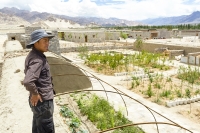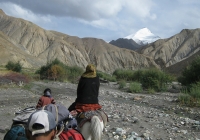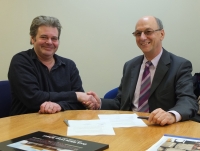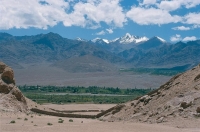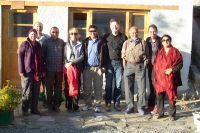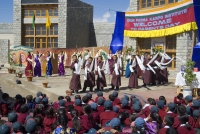Founder, Druk Padma Karpo School
"We should think about a development that gives us a pleasant future, progress that gives a pleasant and prosperous future for us, our children and grandchildren, generation-to-generation, without losing our culture and religion."
Visit https://www.drukpa.org.uk/about/the-gyalwang-drukpa.html to find out more about His Holiness Gyalwang Drukpa
Staff and students from the University of Greenwich (London) Landscape Architecture programmes are helping to make gardens for the school. The design of the Druk Padma Karpo/White Lotus School, by Arup, is based on a Tibetan mandala. ‘Mandala’ is a Sanskrit word. It was used for the sections of the Rig Veda and became associated with a visual symbol, based on a circle and square, used for the layout of temples and the design of stupas and many other sacred objects.
The school and campus were severely damaged by a mudslide in 2010. The site is in a cold desert and there is a great need for a garden and landscape environment. Our hope is to pioneer an approach to cold desert landscape design which will have a wider relevance in the Himalayan region. Global warming is causing the glaciers to retreat and putting the whole area at risk. A University of Greenwich landscape architecture student began work on Druk Padma Karpo in 2012.
The Dragon Garden will transform the school’s environment from a barren desert into a lush and sustainable garden that will be used for learning, playing, sports and food production.
Click here for the history of this exciting project and how volunteer landscape architects can be a part of it
To read some of the landscape architects' reports go to the tab "News", then "Landscape News", or click here.
What is special about the Dragon Garden?
‘Druk’ means ‘Dragon’ and is a Buddhist symbol. Ladakh is one of the last places where traditional Buddhist culture survives and its philosophy has influenced the design.
Few young Ladakhis are enthusiastic about the back-breaking agricultural work endured by their parents and grandparents. They see other opportunities as more attractive, notably in the tourism industry. The best continuation of the ancestral link with the land will be through modern horticulture and gardens. The Dragon Garden will enable some of the younger generation to be inspired and gain relevant hands-on experience. A video about the landscape and garden design is available on YouTube
Urbanisation is consuming previously cultivated land. The Dragon Garden is located in barren desert and will be an exemplar of what can be achieved to bring barren land into productive use with appropriate know-how. Our Landscape and Gardens Strategy is one of sustainability, including elements of conservation, habitat creation and biodiversity. Local people – both adults and children - will be able to experience what this means. By increasing the biomass through extensive planting, the garden will sequester a modest amount of carbon – and set a precedent for the Himalayan region. The school is already engaged in carbon offsetting through its solar energy scheme.
How will the Dragon Garden help children?
The residential students will live in a sustainable environment 24/7, the day pupils during school hours. During their time on campus their cultural heritage and identity will be reinforced by a 'learning through growing' scheme using a plant nursery, greenhouse and residential gardens. 'Learning through play' is a theme in the various gardens on site, using the adventure playground, infant playground and the sports facilities (Multi-Use Games Area, MUGA), cricket field, soccer pitches, athletics field, basketball court and archery range. Student participation in domestic production of fruit and vegetables will in due course introduce them to good horticultural and environmental practices - a modern version of their own heritage – and equip them with useful livelihood skills. The garden will influence students’ values by engendering respect for natural habitats, ecosystems and resources. The Dragon Garden will be an external classroom for teachers to bring lessons to life, where children can learn by ‘doing’, experiencing the joy of seeds growing and seeing various curriculum topics manifesting in nature.
How can the Dragon Garden encourage awareness of and help prepare for climate change?
Education is the answer. Some reputable scientists forecast that the lowest temperatures in 2070 on the Indian sub-continent will be higher than the highest temperatures today. If that turns out to be true, people will face enormous challenges with regard to food production, water availability and many aspects of life. They will need a keen awareness and expertise to find solutions. Students on the campus live with the consequences of a devastating mudslide triggered by unusual climate variations, and have an opportunity to learn relevant knowledge and skills in formal classes and from the external environment.
What can the Dragon Garden teach about conservation?
Being located in a desert area, the top resource to be conserved is water. The school's latrines, for example, are out of the water cycle and use dry composting. Water is used mindfully and we will use drip irrigation to increase the efficiency of water use from about 20% in traditional systems to around 80%. We aim to extend recycling so that all compostable waste is used to create soil, and other items are directed to suitable channels. Small-scale examples foster awareness and help train students, staff and visitors.
What is the link between the Dragon Garden and biodiversity?
The Garden is located in a desert area, with relatively little wildlife in the immediate vicinity. We will increase the biomass and extend the vegetated area, and hope the orchards and shelterbelt will provide a good habitat for birds. Through proximity to diverse plant and animal species (possibly through a small school farm in due course), the students will become aware of biodiversity and will take that awareness with them into adult life.
Who is developing the Dragon Garden?
A Ladakhi non-profit society, Druk Padma Karpo Educational Society (DPKES), is responsible for the school. DPKES has worked with Drukpa Trust, a UK charity, since 1997. They work with the Landscape Department of the School of Architecture, Design and Construction at the University of Greenwich, London.
How can I participate?
You can volunteer to come and help our team to dig, plant and create ... or you can help pay for our landscape team and the materials they need.
What funding is needed?
We have developed a Landscape and Gardens Plan that embraces landscape architecture, garden design and sports facilities. It will enhance the award-winning building architecture by creating gardens and intimate spaces for activity, leisure and study, as well as larger sports areas. In view of the scale of the campus (around 11.5 hectares), we are developing the vision step-by-step over a number of years.
Landscape and Garden Master Plan
Strategic Principles
Water. Water is the fundamental prerequisite for landscape development in Ladakh. The traditional approach involves irrigation channels that conduct melt water to small fields and orchards for flood irrigation. Though the system is well-understood and beautiful, it has several disadvantages: distributing water within fields is labour-intensive; water use efficiency is only about 20%. We are therefore installing a drip-irrigation network on the Druk Padma Karpo campus, which can supply the water necessary for landscape development in an efficient manner and exemplify a sustainable approach in Ladakh.
Soils. The campus is built on the edge of an outwash fan. The area is strewn with granite boulders. It has minimal soil development, with low chemical weathering, and a relative absence of humus and sparse vegetation. To establish a vegetation cover it will be necessary to: encourage or create a vegetable soil with a good range of particle sizes, including sand, silt and clay; improve the availability of nutrients: nitrogen, phosphorous, potassium and trace elements; and build up the humus content of the soil. Kitchen waste, composted toilet waste and any organic material will be treated as treasure.
Microclimate. The growing season in Ladakh is short but productive, with relatively high summer temperatures, much sunshine and a relatively good water supply to the cultivated land. Strong winds and dust storms can however hinder plant growth. Walls, fences, shelterbelts, mulching and ground-covering plants can ameliorate the microclimate and create a virtuous circle for plant establishment.
Vegetation and wildlife. With water, soil and shelter, there is every likelihood that a lush cover of vegetation can be established within the mudslide defence wall around the campus. The traditional Ladakh vegetation types can be created within the site boundary. Horticulturally, they will represent Ladakh’s landscape, comparable to the ideal landscape representations on a ‘mandala’ (a representation of the universe).
Aesthetics and symbolism. The aesthetic character of the school landscape will be influenced by Lakakhi land management traditions, technical and functional issues, the social use of the school grounds, the mandala plan on which the architecture of the school is based, and the Buddhist approach to landscapes and gardens, see YouTube: http://youtu.be/eGIE-qBQPnc
Environmental sustainability. The people of Ladakh have sustained their local environment for thousands of years, but it is now being affected by climate change. Amid such change, it will be important to conserve what can be conserved while learning from the emerging technologies of a sustainable approach to environmental design - the outdoor equivalents of the award-winning trombe walls and solar-assisted toilets.
Wildlife and biodiversity. Planting on the campus is being planned to enhance biodiversity, with special consideration for creating ornithological habitats because birds serve as marker and indicator species for habitat types, and because birds are a delightful component of a school environment.
Environmental and vocational education. The school external environment will be a teaching and learning resource. This approach has been fostered by the Learning Through Landscapes Trust in the UK. The campus can be a teaching resource, a research resource, a preparation for careers in landscape management, eco-tourism and cultural tourism - and an exemplary project for the Himalayan region.
This is a small project in terms of area, but a highly significant demonstration project for the future of Ladakh. We aim to create a sustainable landscape and garden environment relating to Tibetan Buddhist culture, which students, local people and visitors can enjoy and learn from. We will establish:
- new habitats for native flora and fauna, where people can learn about nature, and develop an awareness of climate change, biodiversity and conservation;
- good quality sports facilities to foster personal health and team work; and
- opportunities for young people to get ‘hands-on’ experience of gardening, hopefully be inspired by it, develop a love for nature, and take their passion and livelihood skills on their life journey.
Projects
Plant Nursery. Ladakh does not have a developed horticultural industry that can supply plants. The school therefore requires its own plant nursery and we initiated our own in 2012. This is an on-going developmental project that can potentially give some of the children commercially useful skills.
Drip Irrigation. This is a pioneering opportunity to develop the use of modern drip-irrigation technology in a cold desert and to spread knowledge of its use to the homes and farms of the families who send their children to the school. We have invested in the core system and need continual expansion.
Garden Team. The head gardener and gardener care for the features created with help from international volunteers. They also maintain the gardens, plants, landscape infrastructure and sports facilities throughout the year. They are key to the whole process.
Adventure Playground. The adventure playground is under construction using natural materials that encourage students to run, climb and play – experiencing different textures and sounds.
Residential Courtyard Gardens. In each of the four residential courtyards, window planters will be complemented by external seating areas and other features.
Dragon shelterbelt. The School will benefit from protection by shelterbelts planted with Buckthorn (Hippophae rhamnoides) and the Ladakh Rose (Rosa macrophylla).
Fruit orchard. With drip irrigation instead of flood irrigation, a range of fruit trees can be grown on the campus, including apricots and apples. We plan to plant and irrigate 9,000m2 in this way.
Sports Facilities. For earthworks and to provide materials and equipment for sports facilities for the school’s own use and to enable it to host interschool meetings. The facilities will provide for cricket (of course), soccer, athletics, basketball, traditional archery and tennis.
We also plan to develop the following features:
• Themed Gardens. Healing, music and science gardens are planned. Ladakh has a rich heritage of medicinal plants and long experience with its own Amchi tradition. A healing garden will showcase local medicinal plants. Music and science gardens will encourage the students to learn through play in these leisure spaces.
• Multi-Use Games Area, MUGA. The ground is dry and sandy, which is not ideal for many sports. A hard-surfaced MUGA will create a clean surface for various courts to be marked out. The MUGA will ease the pressure on the basketball court, which is currently the only decent hard surface for games.
• Serpentine paths. The routes between buildings are currently surfaced with sand and dust from the desert. The aim is to pave selected routes in slate.
• Dragon entrance and gates. The green bodies of the Dragon shelterbelts, which will enclose and protect the school, will meet at the entrance in the south-east corner of the site. This will be a good location for Dragon Gates, inspired by the use of dragon symbols in Ladakhi art (e.g. the Dragon Throne at Hemis).
• Lotus pond. 'Padma Karpo' translates as 'white lotus' and there is every reason to have a lotus pond on site. Nelumbo nucifera does not tolerate frost, but can flourish out of doors in summer. It will require protection in winter. Sacred to Buddhists and Hindus, the lotus is the national flower of India. Filled by seasonal meltwater, the pond will be a haven for wildlife and plant life in summers and a place for the children to ice-skate in winter.
• Outdoor theatre/amphitheatre. Built using mud-brick and rammed earth, an amphitheatre will provide the school with the facilities for music, dance and drama, as well as being a platform for public events.
-Cropped.jpg)
(This will be 07h00 in Los Angeles & Victoria/ 10h00 New York/ 15h00 London/ 16h00 Germany/ 19h30 India/ 21h00 Phuket/ 22h00 Malaysia, Shanghai & Singapore.) Join us in viewing the webcast even if you are not hosting a party.
School Patrons send their birthday greetings:
Lord and Lady Cowdray: “Happy 10th Anniversary to The White Lotus School. It has been our privilege to be a part of this enlightening project and we have enjoyed watching it flourish and thrive. May the next ten years be all that you wish it to be. We send you our blessings and love Michael and Marina Cowdray."
Joanna Lumley: “Thousand congratulations. Happy Birthday and all my love, Joanna.”
Sometimes known as ‘Little Tibet’, the Union Territory of Ladakh is an ancient kingdom in north-west India, bordering Pakistan and the Tibet Autonomous Region. The Union Territory of Ladakh has two districts Leh and Kargil.
The Leh Valley lies at an altitude of about 3,500 metres and the surrounding mountains rise to over 6,000 metres. The area is remote: the main road linking Ladakh with the rest of India is cut off by snow for six months or more each year. This is a high-altitude desert environment where water is precious. Agriculture and human settlements depend on water from snow melt, which flows towards the Indus River.
Traditionally, most Ladakhis were subsistence farmers growing mainly barley and vegetables, or they were nomads tending goats and yaks. The opening of a road in the 1960s linking Ladakh with the plains brought large numbers of army personnel and the spread of the Indian civil administration.
The private sector is small, comprising mainly seasonal, tourism-related activities. There are few substantial companies, however there is an increasing number of new business entrepreneur role models among the Buddhist community. The main aim in life for many young Ladakhis is to obtain government employment, even though few such jobs are available.
A Society and Culture Under Threat:
Ladakh is experiencing:
- Challenges to local water supplies as glaciers melt as a consequence of climate change,
- A shift away from traditional agriculture, with people drifting to the towns and associated uncontrolled urbanisation,
- Cultural erosion,
- Knowledge and skills gaps,
- A continuing focus on rote-learning in schools, which ill-equips young people for the modern world,
- Over-dependence on government jobs, which have become very scarce, and a weak economic private sector, resulting in increasing youth unemployment with associated social risks.
Druk Padma Karpo runs an active cooperation programme in order to mobilise the best people and resources from within Ladakh, the rest of India and internationally. We work with educational institutions (notably from India, the UK and the USA), corporate partners, NGO's, individual experts and volunteers. Participants from many countries bring their knowledge, experience and material resources that add value to the life of the school and the students
Organisations
The following organisations have contributed to the success of our school:
- Aditya Birla International School, Bangalore
- Anant National University - Dr Pramath Sinha, Provost
- Arup
- Aseem Foundation, Pune
- Autodesk
- BaSiC Initiative, USA
- Childreach International
- Goldenmile Learning, Mumbai
- IAHV Read Library
- JetAirways
- kontentreal
- La Ngonpo Project
- Lille Fro Foundation
- Live to Love, International
- Mayacamas Landscape Architecture, CA, USA
- Mind Mingle, Delhi
- Mountain Kingdoms
- Nature Conservation Foundation, Bangalore
- NEEV Academy, Bangalore
- New Lives, India
- Nirmal Bhartia School, Delhi
- Ogilvy & Mather, Los Angeles
- Peaks Foundation, UK
- Podar World School, Gurjarat
- PRAVAH
- SEEDS
- Snow Leopard Conservancy, India
- SP Jain Institute of Management & Research Mumbai
- St. Christopher School, Letchworth, UK
- University of Cambridge Primary School, UK
- University of Greenwich, UK
- Vinod Chopra Films
Partner - Drukpa Trust team in England
Drukpa Trust is a registered charity in England, number 1178756, and has been involved since the inception of the school project in the 1990's
The Trust has six trustees and one part-time employee:
| Chair: Dr Steven Robert Todd |  |
| Deputy Chair: Annie Smith |  |
| Jonathan Rose RIBA |  |
| Treasurer : Di Cook |  |
| Wendy Cornwell |  |
| Roland Reinardy |  |
| Project Manager: Rachel Glynn |  |
You can contact Drukpa Trust via the project manager by emailing: This email address is being protected from spambots. You need JavaScript enabled to view it.
Copyright
Druk Padma Karpo School would like to thank the following for allowing us to reproduce their work on this site:
- Arup
- Graham Brandon
- Jennifer Chandler
- Philip Cornwell
- Wendy Cornwell
- Julayne Farmer
- Rachel Glynn
- Chinch Gryniewicz
- Ian Hazard
- BaSiC Initiative
- Sebastian Kaminski
- Michael Kern
- Connor McGrath
- Dick Polak
- Rupam Ray
- Roland Reinardy
- Christian Richters
- Sudhir Sinde
- Annie Smith
- Robert van Sluis
- Emilie van Wijnbergen
- Katerina Zographou
If you would like to reproduce any material found on this site, please contact us so that we can help you organise the appropriate permissions or licences
Responsible Tourism in Ladakh
Mountain Kingdoms (UK) has an ethical tourism policy and its clients offset their carbon travel footprint by investing in the Druk Padma Karpo solar energy system
Patrons
Richard Gere

Richard Gere is an American film actor, a well-known Buddhist, and an active supporter of His Holiness the Dalai Lama and a keen supporter of Tibetan cultural preservation
Joanna Lumley OBE FRGS

Joanna Lumley is a British actor who was born in Kashmir. She is a campaigner for the preservation of Tibetan culture and has an interest in and concern about environmental matters, sponsoring the Joanna Lumley Fellowship in Environmental Science at the University of Oxford.
The Viscount and Viscountess Cowdray

"We are pleased to support the good work of the Druk Padma Karpo School. The Ladakhi children benefit hugely from the school, in communities where schooling would otherwise not be available. We are glad to see the school growing in strength and number since its beginning in 2001 and continue to fund raise on their behalf".
The Rt. Hon. the Dowager Countess Cawdor

Countess Cawdor is an enthusiastic supporter of DPKS and is keen to see the school extend into further education territory.
Drukpa Trust (a charity registered in England No.1178756) supports the school through capital fundraising and project management of the design and construction. Drukpa Trust was founded in 1992 at the inception of the school project and His Holiness the 14th Dalai Lama was a founding Patron.
"The idea of having a modern school which lays equal importance on preserving the valuable aspects of a traditional culture is very encouraging. I have always believed in giving equal importance to both modern, scientific knowledge and traditional Buddhist culture. A proper synthesis can give rise to positive result."
Live to Love, an international NGO supports the school through capital fundraising and value-added educational resources. His Holiness The Gyalwang Drukpa initiated the Live to Love movement, a secular philosophy that encourages communities to use kindness and wisdom to heal the modern world’s challenges, and to celebrate diversity of faiths and cultures. Live to Love International is the resulting global network of non-profit organisations focused on those goals, pioneering multiple local and cross-border projects throughout the Himalayas and beyond.
Supporters
The Yardbirds

One of the most influential rock bands of all time, the Yardbirds launched the careers of Jimmy Page, Eric Clapton and Jeff Beck. In their current line-up, with original member James McCarty, the Yardbirds have played several gigs for the benefit of Druk Padma Karpo School.
Donovan Philips Leitch

Donovan has been involved with the school for many years, even visiting the site in Shey before construction started. He was the featured artist in January 2008 for the first "Sounds of Our Times" radio concert in New York. Druk Padma Karpo School was his charity of choice.
This section contains a selection of downloadable documents relating to different aspects of the school. They are all in pdf format - adobe acrobat is available as a free download from adobe.com
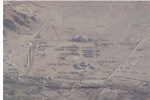
A Journey in Ladakh - the Challenges
Aerial View Shey Campus April 2009
Construction Progress - photo diary 2012
Drukpa Trust Annual Report 2012-13
Lotus Leaves Autumn 2013 (Indian Rupee INR)
Lotus Leaves Autumn 2013 (US$)
Lotus Leaves Autumn 2013 (GB£)
Lotus Leaves Autumn 2013 (Euro €)
Lotus Leaves Newsletter Spring 2015 (GB£)Lotus Leaves Newsletter Spring 2016 (GB£)Mudslide Update August 2011 US$
Mudslide Update August 2011 GB£
Programme to Completion of Secondary School - October 2013 GBP (£)
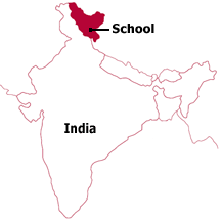 We are an award-winning project, inspired by the vision of His Holiness the Gyalwang Drukpa, a spiritual leader of Ladakh. Our school offers an education that grounds students firmly in their own culture and equips them to thrive in the modern world.
We are an award-winning project, inspired by the vision of His Holiness the Gyalwang Drukpa, a spiritual leader of Ladakh. Our school offers an education that grounds students firmly in their own culture and equips them to thrive in the modern world.
The main school is located in Shey, the ancient capital of Ladakh, which is about thirty minutes' drive up the Indus Valley from the main town of Leh. A branch school opened in Khachey in April 2010.
Students study Bothi (the local language), English and Hindi languages, plus sciences, social studies, creative arts and sports. They learn life and livelihood skills, including team work, presentation skills, leadership and problem solving through formal and co-curricular activities.
The school is known locally as the Druk Padma Karpo School - Padma Karpo means White Lotus in Bothi - and is named after Mipham Pema Karpo (1527-1592), who is revered as a great scholar.
This unique initiative is managed by the Druk Padma Karpo Education Society, a local non-profit society, with support from Live to Love, Drukpa Trust (UK charity no 1178756 under the patronage of His Holiness the 14th Dalai Lama), the Drukpa Charitable Foundation (a US 501(C)(3) organization) and Drukpa Humanitaire (France).
The school is split into four houses - Courage, Wisdom, Unity and Harmony


